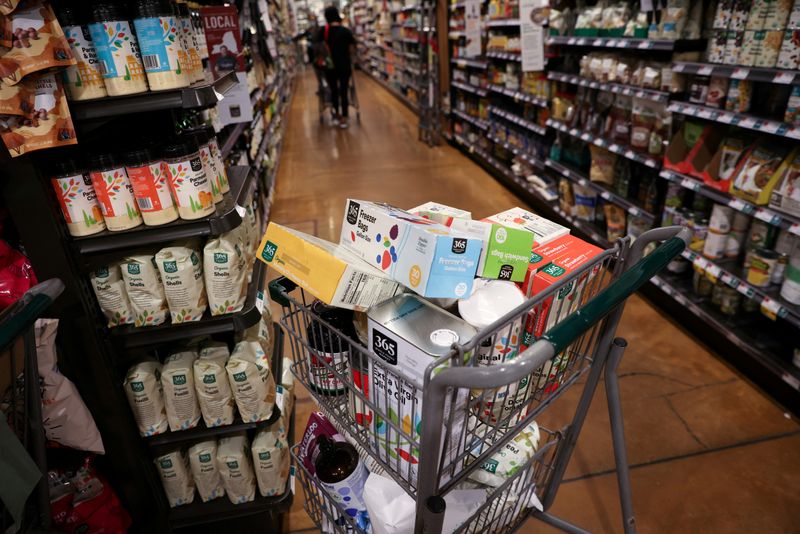By Lucia Mutikani
WASHINGTON (Reuters) - U.S. consumer prices accelerated in January as Americans continued to be burdened by higher costs for rental housing and food, suggesting that the Federal Reserve was far from pausing its interest rate hiking campaign.
The report from the Labor Department on Tuesday also showed the pace of disinflation in the annual consumer price measures slowing last month. Still, the continued gradual slowdown in inflation likely keeps the Fed on a moderate interest rate hiking path. Sticky inflation and a stubbornly tight labor market have led some economists to expect that the U.S. central bank could continue hiking rates through summer.
"Inflation is easing but the path to lower inflation will not likely be smooth," said Jeffrey Roach, chief economist at LPL Financial (NASDAQ:LPLA) in Charlotte, North Carolina. "The Fed will not make decisions based on just one report but clearly the risks are rising that inflation will not cool fast enough for the Fed's liking."
The consumer price index increased 0.5% last month after gaining 0.1% in December. A 0.7% rise in the cost of shelter, which mostly reflected rents, accounted for nearly half of the monthly increase in the CPI.
Inflation was also boosted by rising gasoline prices, which rebounded 2.4% after declining for two straight months. Americans also paid more for natural gas and electricity.
There were also increases in prices of food, which rose 0.5% after advancing 0.4% in December. The cost of food consumed at home climbed 0.4%, lifted by rising prices for meat, fish and eggs. Prices for cereals and bakery goods rose as did nonalcoholic beverages, but fruits and vegetables cost less.
January's increase in the CPI was in line with economists' expectations. Economists said some of the rise in the monthly CPI reflected price increases at the start of the year, mostly evident in the 2.1% surge in prescription drugs and 1.2% jump in motor vehicle fees.
"In today's higher-inflation environment, firms are likely to implement larger price increases when they reset their prices than they normally would when inflation was low and stable, leading the seasonal factors to underestimate inflation at the start of the year when price resetting is more common," economists at Goldman Sachs (NYSE:GS) wrote in a note.
The Labor Department's Bureau of Labor Statistics (BLS) also updated the seasonal adjustment factors, the model that it uses to strip out seasonal fluctuations from the data.
Spending weights used to calculate the CPI were also updated effective with January's report. The new weights, reflecting consumer spending in 2021, were seen as inflationary for January's report. Housing now has a bigger share in the CPI, while weights for transportation and food were lowered.
In the 12 months through January, the CPI increased 6.4%. That was the smallest gain since October 2021 and followed a 6.5% rise in December. The revisions to 2022 CPI account for the modest slowdown in the year-on-year CPI.
The annual CPI peaked at 9.1% in June, which was the biggest increase since November 1981.
President Joe Biden said in a statement that the CPI report "reinforces that we have made historic progress and are on the right track, and now we need to finish the job."
Stocks on Wall Street were trading lower. The dollar was steady versus a basket of currencies. U.S. Treasury prices fell.
(Inflation https://www.reuters.com/graphics/USA-STOCKS/lbpggbxqmpq/inflation.png)
GOODS DEFLATION PAUSES
The moderation in annual inflation reflects tighter monetary policy, which is weighing on demand, as well as improved supply chains. But it will be a while before inflation moves back to the Fed's 2% target.
The Fed has raised its policy rate by 450 basis points since last March from near zero to a 4.50%-4.75% range, with the bulk of the increases between May and December. Two additional rate hikes of 25 basis points are expected in March and May. Financial markets are betting on another increase in June.
"The risks lie on the upside for further rate increases," said Kathy Bostjancic, chief economist at Nationwide.
Excluding the volatile food and energy components, the CPI increased 0.4% after rising 0.4% in December. In addition to the 0.7% advance in owners' equivalent rent (OER), a measure of the amount homeowners would pay to rent or would earn from renting their property, the so-called core CPI was also supported by higher prices for apparel. OER increased 0.8% in December.
Independent measures, however, suggest rental inflation is cooling, leading many economists to believe that price pressures could decelerate considerably in the second half. The rent measures in the CPI tend to lag the independent gauges.
Healthcare costs fell 0.4%. Excluding food, shelter and energy, the CPI rose 0.2% after gaining 0.1% in December. Prices for used cars and trucks fell 1.9%, while the cost of apparel increased 0.8%, the largest gain since December 2021. Core goods prices rose 0.1%, increasing for the first time since August.

In the 12 months through January, the core CPI advanced 5.6%, the smallest gain since December 2021, after rising 5.7% in December.
"We continue to look for inflation to trend lower, but we believe getting back to an inflation rate the Fed can live with on a sustained basis will neither be quick nor painless," said Sarah House, a senior economist at Wells Fargo (NYSE:WFC) in Charlotte, North Carolina.